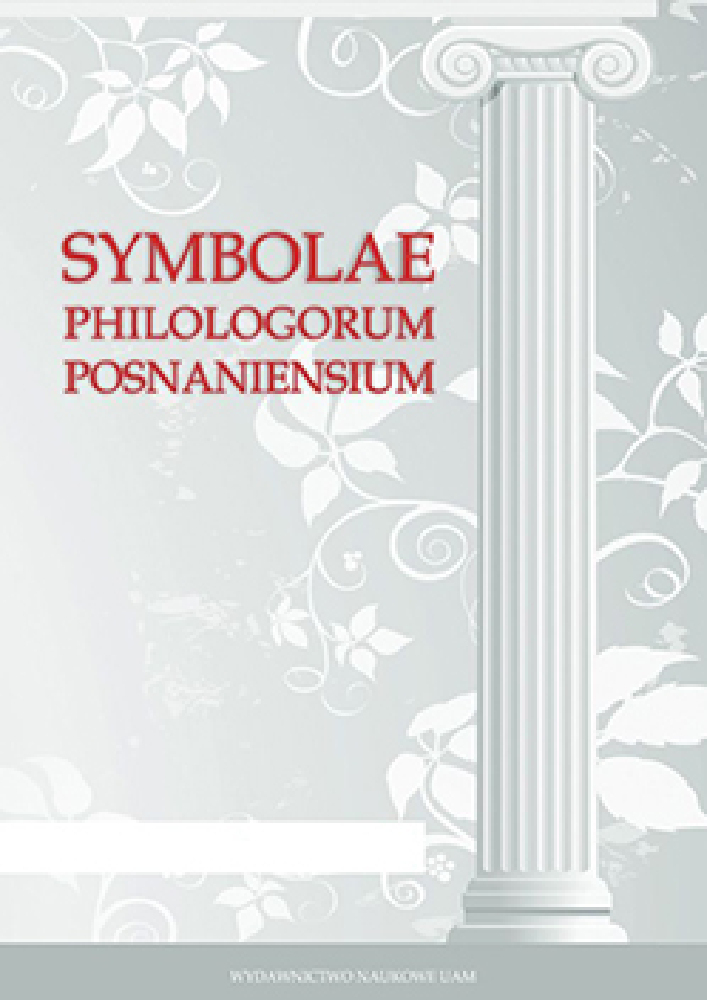Abstract
The most famous line from Terence, homo sum etc. (Heautontimoroumenos 77), has been interpreted in different ways under different circumstances by authors ranging from Cicero and Seneca in antiquity and Erasmus at the beginning of the modern age to figures of the 19th and 20th centuries, such as Friedrich Nietzsche, George Bataille, and Thomas Mann. Augustine of Hippo was the first to refer to Terence within a broader Christian context, and in the 12th century John of Salisbury equated the presumed philanthropic attitude of the Roman comedian and imitator of Menander with charity, the ultimate Christian virtue. Whereas most of the testimonia to the reception of Heautontimoroumenos 77 have already been identified and in part analyzed, a refined indirect ῾quotation᾿ of the line in question has been neglected: In a sort of réécriture of the initial scene of Terence’s drama, Roswita (Hrotsvit) of Gandersheim (10th century), in her hagiographic comedy ῾Abraham᾿, interpreted the even then proverbial sentence by introducing for the attitude of ῾humanity towards one’s neighbour᾿ both the Aristotelian definition of friendship (῾one soul in two bodies᾿) and a reference to the ideal of a Christian society with ‘one heart and one soul᾿ (Acts 4, 32). Thus the Terentian humanum is bothparaphrased by and identified with both an other classical and a Christian concept of mutual human affection.
Literaturhinweise
Editiones et commentaria
Opera omnia Desiderii Erasmi Roterodami, tom. I, vol. 2, ed. P. Mesnard†, Amsterdam 1971.
Erasmus von Rotterdam, Ausgewählte Schriften, vol. 8, Ciceronianus, Adagiorum Chiliades, ed. Th. Payr, Darmstadt 2016.
Hrotsvithae Opera, ed. H. Homeyer, München 1970.
Hrotsvit, Opera omnia, ed. W. Berschin, München 2001.
Epistolarium Iohannis Sarisberiensis, ed. W.J. Millet, H.E. Butler, C.N.L. Brooke, Oxford 1979.
Studia aliaque subsidia
Brunhölzl 1992: F. Brunhölzl, Geschichte der lateinischen Literatur des Mittelalters, vol. 2, München 1992.
Dronke 1992: P. Dronke, Women Writers of the Middle Ages, Cambridge (UK) 1984.
Fürst et alii 2006: A. Fürst, Th. Fuhrer, F. Siegert, P. Walter (eds.), Der apokryphe Briefwechsel zwischen Seneca und Paulus, Tübingen 2006.
Gonzáles Caballo 2016: A. Gonzáles Caballo, Hrotsvithas Dramen und Terenz. Diese Problematik in „Abraham“, Universidad de Salamanca, Trabajo de fin de grado 2016: https://gredos.usal.es/handle/10366/132758 (29.05.2021).
Gorys 2005: E. Gorys, Lexikon der Heiligen, München 2005.
Jocelyn 1973: H. D. Jocelyn, „Homo sum: humani nil a me alienum puto (Terence, Heauton timorumenos 77)“, Antichton 7 (1973), 14–46.
Hau 1982: W. Hau, Sponti-Sprüche. (Ich geh kaputt, gehst du mit?), Frankfurt am Main 1982.
Lefèvre 1986: E. Lefèvre, „Ich bin ein Mensch, nichts Menschliches ist mir fremd“, in: Wegweisende Antike: zur Aktualität humanistischer Bildung; Festgabe für Günter Wöhrle, ed. O. Hering (Humanistische Bildung: Beiheft 1), Stuttgart 1986, 39–49.
Lesky 1971: A. Lesky, Geschichte der griechischen Literatur, München 1971.
Primmer 1966: A. Primmer, „Die homo-sum-Szene im Heautontimorumenos“, Wiener Studien 79 (1966), 293–298 (= Texte zur Handlungsgliederung in Nea und Palliata, Berlin – New York 2015, 27–30).
Rädle 1983: F. Rädle, “Hrotsvit von Gandersheim”, in: Die deutsche Literatur des Mittelalters, Verfasserlexikon 4, Berlin – New York 19832, coll. 196–210.
Smolak 2001a: K. Smolak, “Gentilium delicias abstinendo devito. Die Dramen der Hrotsvit von Gandersheim als anagogische Einheit“, in: Pontes I (Akten der ersten Innsbrucker Tagung zur Rezeption der klassischen Antike), ed. M. Korenjak, K. Töchterle, Innsbruck 2001,162–179.
Smolak 2001b: K. Smolak, recensio: “A. Tamerl, Hrotsvith von Gandersheim. Eine Entmystifizierung, Gräfelfing 1999“, in: Anzeiger für die Altertumswissenschaft 53, 3/4 (2001), coll. 226–241.
Smolak 2010: K. Smolak, „Three Latin Paratexts from Late Antiquity and the Early Middle Ages (‘Sulpicia’, ‘Seneca’ – ‘Paulus’, Carmen Navale)”, in: In the Second Degree. Paratextual Literature in Ancient Near East and Ancient Mediterranean Culture and its Reflexions in Medieval Literature, ed. by Ph.S. Alexander, A. Lange, R. Pillinger, Leiden–Boston 2010, 219–237.
Staubach 1991: N. Staubach, “Graecae Gloriae. Die Rezeption des Griechischen als Element spätkarolingisch-frühottonischer Hofkultur”, in: Kaiserin Theophanu. Begegnungen des Ostens und Westens um die Wende des ersten Jahrtausends, vol. 1, ed. A. von Euw, P. Schreiner, Köln 1991, 343–368.
Wimmer, Melzer 1982: O. Wimmer, H. Melzer, Lexikon der Namen und Heiligen, Innsbuck–Wien–München 1982.
Lizenz
